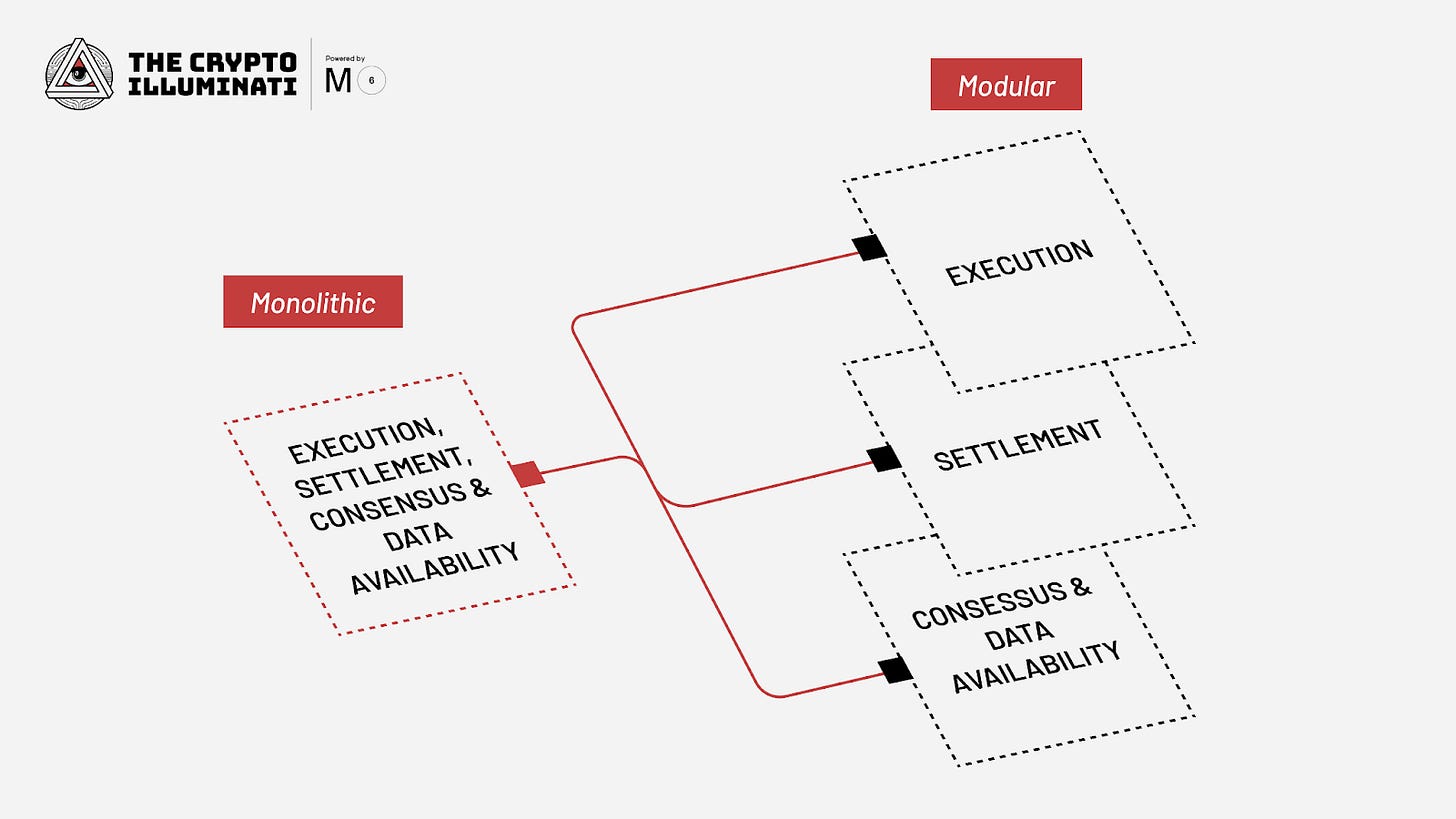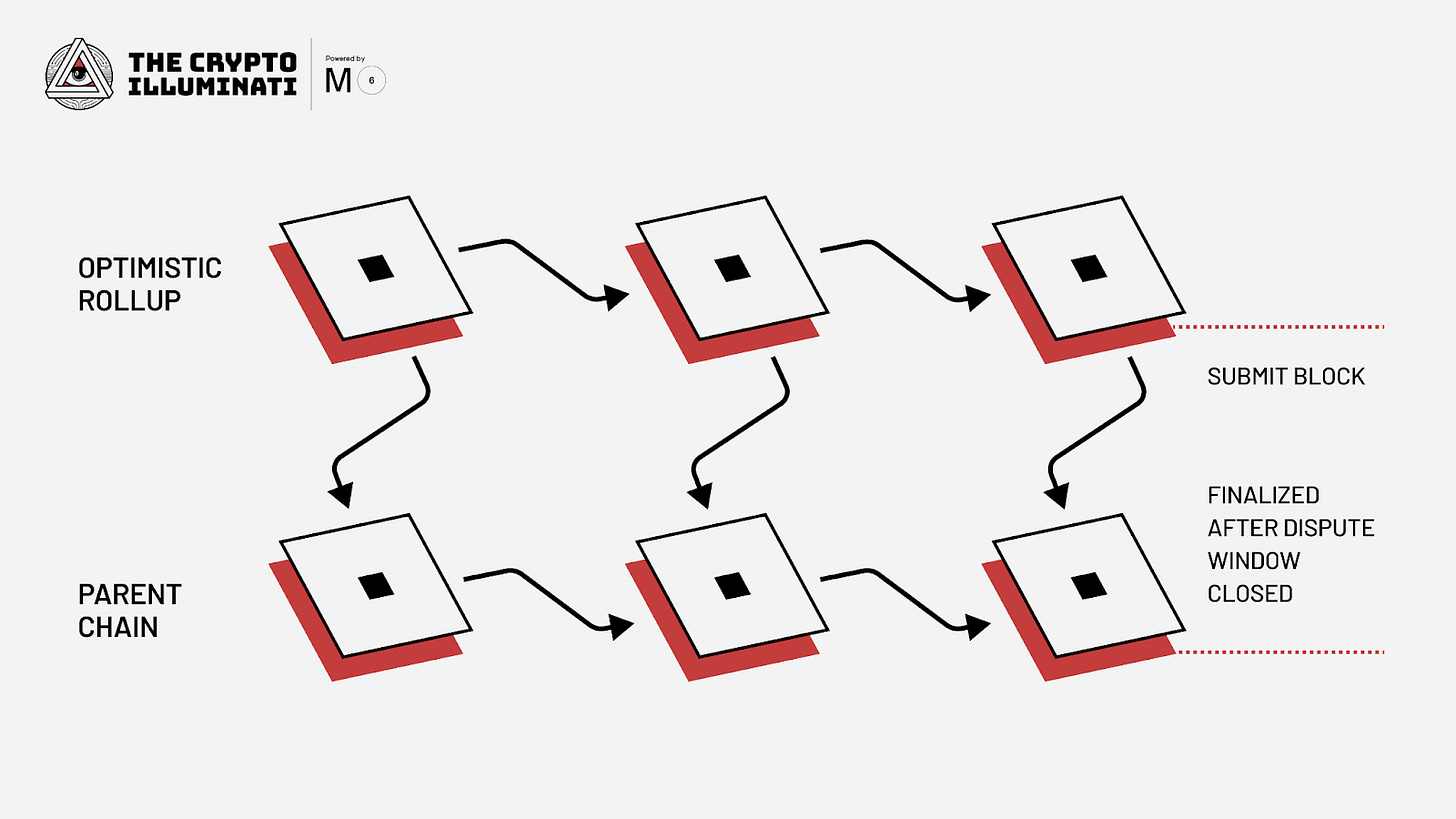How modular architecture is revolutionizing the world of blockchain technology
by Russian Defi
🔗 Introduction to Blockchains
Even if you are unfamiliar with blockchain, you may already know that it is the technology that makes cryptocurrencies like Bitcoin possible. However, there are also other uses for this technology.
The distributed ledger used for bitcoin transactions, known as blockchain, was first introduced in 2008. Since then, the technology has developed a life of its own and has garnered interest from many sources.
Today, we may see widespread use of blockchain technology; governments, businesses, and other organizations and industries are researching and deploying blockchain technology to meet various needs, most of which have nothing to do with digital currency. Blockchain offers security, immutability, traceability, and transparency across a distributed network, making it suitable for use cases that conventional infrastructure now finds challenging to serve.
🧱 What is a Modular Blockchain?
There is a lot to be said when it comes to blockchain. You may have read about the evolution from monolithic to modular designs that several blockchains are working on. In this text, we will delve deeper into the topic of modular blockchains, discussing who uses them, what they are used for, where they are employed, when they are most useful, and how they work. Perhaps we should start by defining modularity.
“ Modularity represents using individually distinct functional units, as in assembling a system. In the case of blockchains, it would be splitting the core functions of a blockchain into different applications that can be swapped easily“
Monolithic blockchains
Let’s start at the beginning. Before we delve deeper into modular blockchains, we should first discuss what a monolithic blockchain is. A monolithic blockchain is a type of blockchain architecture that tries to handle everything from execution to consensus to data availability within the blockchain (we will discuss the layers in more detail in the next section).
This means that all validators and full nodes perform consensus and chain execution. For example, both the Bitcoin and Ethereum blockchains are monolithic. Ethereum replaced Bitcoin’s execution layer with a general-purpose smart contract environment called the Ethereum Virtual Machine.
Or, to put it another way, monolithic blockchains are chains that handle all four functions at the same time.
Monolithic blockchains do everything on a single layer, while a modular stack splits components across multiple layers.
Modular vs monolithic chains
This is why blockchain experts have developed the concept of modular blockchains as a solution. Monolithic blockchains have experimented with various scaling solutions over time, most of which have failed. Modular blockchains allow for a monolithic blockchain to be divided into several specialized layers, allowing each layer to implement scalability mechanisms that might have required many sacrifices in a monolithic architecture.
This issue has led to the development of various architectures that attempt to support all users on a single chain or a closely related group of chains that are part of a single network. However, this approach becomes constrained and difficult when scaling a system for millions or even billions of users. To address this problem and give layer one more scale, techniques such as sharding and layer two blockchains were developed.
The idea of dividing blockchains into distinct components first arose from the idea that a single blockchain doesn’t have to do everything on its own, and modular blockchains are the next step in this evolution.
Modular blockchains can create ideal, sovereign, scalable, and secure systems by dividing their processes among multiple specialized layers. This modular structure allows different technologies to perform functions that are best suited to their capabilities within a blockchain.
A modular blockchain is a type of blockchain that specializes in only a few functions rather than all of them. Because of this, modular blockchains are arranged in a stack that combines to achieve the same functions as a monolithic chain. That’s why it is important to note what is NOT a modular blockchain:
- A blockchain that handles all components but has a modular software design
- A network of blockchains where each blockchain handles all components (e.g. subnets – as each chain in the subnets handles all the layers)
1️⃣ The First Principles of Modular Blockchains
To understand modular blockchains better, we should mention the “First Principles of Modular Blockchains.”
- Decentralization – it is well known that one of the most significant differences between blockchains and traditional distributed systems is that they are open and verifiable by anyone. Since verifiability is the core difference between web2 and web3 systems, we measure decentralization by the number of users who can verify the chain directly. The more users running nodes, the greater the decentralization, making the blockchain more resistant to attacks. Modular blockchains prioritize decentralization for network security by reducing the cost for users to operate nodes and verify the network.
- Scalability – occurs when a blockchain can process more transactions without increasing the cost for nodes to validate those transactions. The primary characteristic of scalability in modular blockchains ensures that they can expand their capacity without making it prohibitively expensive for users to validate the network. The use of technologies like fraud proofs, validity proofs, and data availability sampling in the modular blockchain stack allows nodes to verify transactions more quickly than full nodes while maintaining the same level of security.
- Security covers many aspects, but validators and miners are crucial components of blockchain security. Most Proofs of Stake blockchains have a validator set consisting of a group of nodes tasked with validating and adding transactions to the chain. Proof of Stake blockchains require nodes to stake tokens as a security deposit to participate as a validator. Slash, a method for punishing malicious validators, involves burning their stake. Automatic punishment can be applied through slashing, reducing their stake, or social consensus, which forks away from the malicious validators. Users who verify and enforce the chain’s rules act as the final checks and balances on power and security.
🏢 Modular Blockchain Architecture: Execution, Settlement, Consensus & Data Availability
Now, let’s focus on the question: “What is modular blockchain architecture?”
A modular blockchain can manage the following tasks in one or more ways:
- Execution: Enables the execution of transactions and the implementation and use of smart contracts.
- Data availability: Ensures that transaction data is accessible.
- Consensus: Agrees on the details and chronological order of transactions.
- Settlement: Establishes a layer for concluding transactions, resolving conflicts, approving evidence, and connecting various execution layers.
An example of a modular blockchain is rollups. While a roll-up chain executes transactions, the parent chain is responsible for consensus, data availability, and settlement. A modular chain often performs two or more tasks, especially if they are related.
For example, data availability layers must agree on the order of the data; otherwise, it will be difficult to determine which data reflects the accurate version of history.
Since we have already mentioned rollups, it’s time to discuss Celestia’s Optimint in more detail. Optimint is an official sovereign rollup-based settlement layer that uses an optimistic rollup to link the Celestia consensus and data availability layer to the execution layer on the new chain. Tendermint, a foundational consensus layer for the Cosmos SDK, is also replaced by Optimint.
💫 Celestia: A Modular Blockchain Network
What is Celestia, and how does Celestia contribute to the modular blockchain ecosystem?
There are several things worth noting about Celestia.
It is important to note that Celestia is the first modular blockchain network with data accessibility and a consensus layer.
Celestia also creates some settlement layers, like Optimint, for developers. After combining Celestia and Optimint, only the execution layer remains for the developer to build a new blockchain.
Celestia addresses the scalability issue using new blockchain technology. The consensus and data availability layers of the blockchain are separated from its execution layer in Celestia’s modular architecture, which avoids bundling everything together on the blockchain.
There are many reasons to keep an eye on Celestia. However, one thing is certain: using Celestia’s high throughput data availability while maintaining a higher level of security than other off-chain data availability techniques offers an exciting combination of safety and scalability.
This effectively enables better scalability. It is always interesting to look for promising projects with great potential, and we would surely choose Celestia’s modular blockchain. However, early in its development, it seems to be an optimistic attempt at solving the scalability trilemma with its innovative modular blockchain architecture. In theory, this design improvement will enable Celestia to achieve much higher levels of scalability, flexibility, and interoperability than its predecessors.
What are the benefits of Celestia’s modular blockchains?
- Sovereignty – New modular blockchains can be sovereign like layer 1s, utilizing other layers. This allows the blockchain to respond to hacks and push upgrades without permission from any underlying layers.
- Launching new blockchains – New blockchains can use existing modular blockchains for the components they want to offload because modular blockchains don’t have to handle all functions. This makes it possible to efficiently bootstrap new blockchains, cutting down on deployment time and cost. For example, using the Cosmos SDK and a roll-up “SDK” like Optimint will make it easier to create new blockchains without needing to bootstrap a secure validator set.
- Scalability is possible without compromising security or decentralization by dividing them into several tiers. As a result, a decentralized, multi-chain environment is consistent with sustainable blockchain scalability.
It is always exciting and inspiring to become part of the growing community of developers and innovators who are helping to build something great like the Celestia network, so don’t forget to check out their social media as well as Discord and Telegram channels. Celestia has already managed to generate a lot of buzz in the media. We’ve already had a chance to read articles about the network published by CoinDesk, Finance. Yahoo, Blockchain Council, etc.
If you have any technical questions about Celestia tools, their developers are happy to answer them on their Telegram channel. If you’re interested in the latest news and updates, check their Twitter account and as a developer, don’t hesitate to participate in engineering discussions on their GitHub.
The Future of Modular Blockchains with Celestia
Celestia will soon have a token that will be used to secure the network through Proof of Stake and to pay transaction fees on the network.
They plan to implement a fee-burn mechanism similar to EIP-1559 in Ethereum so that burnt fees will offset new token issuance as Celestia gains adoption. With so much to come, their roadmap looks very exciting and promising, and we will keep you updated on everything happening with this great project.
As they address the flaws and limitations of monolithic architecture, modular blockchains can create a new paradigm shift in how Web3 applications are developed. Celestia is at the forefront of this new paradigm shift. Given Celestia’s potential and what it promises to offer to Web3, I’d say the attention and excitement around it are justified. I expect we will see a lot of hype around Celestia as time goes on.
A Summary, & Conclusion
It’s time to summarize, and today we learned a lot about modular blockchain, which consists of four layers: execution, settlement, consensus, and data availability.
Developers are responsible for developing only the execution layer if they create a new chain using Celestia and Optimint. Optimint is an official sovereign rollup-based settlement layer created by Celestia, which is fully compatible with the Cosmos SDK. Developers can integrate any Cosmos SDK modules into Optimint.
Celestia has already provided two examples for Optimint: Wordle chain and CosmWasm. Modular blockchains are the result of separating the core components of a single blockchain and running them on separate layers, making them powerful.





